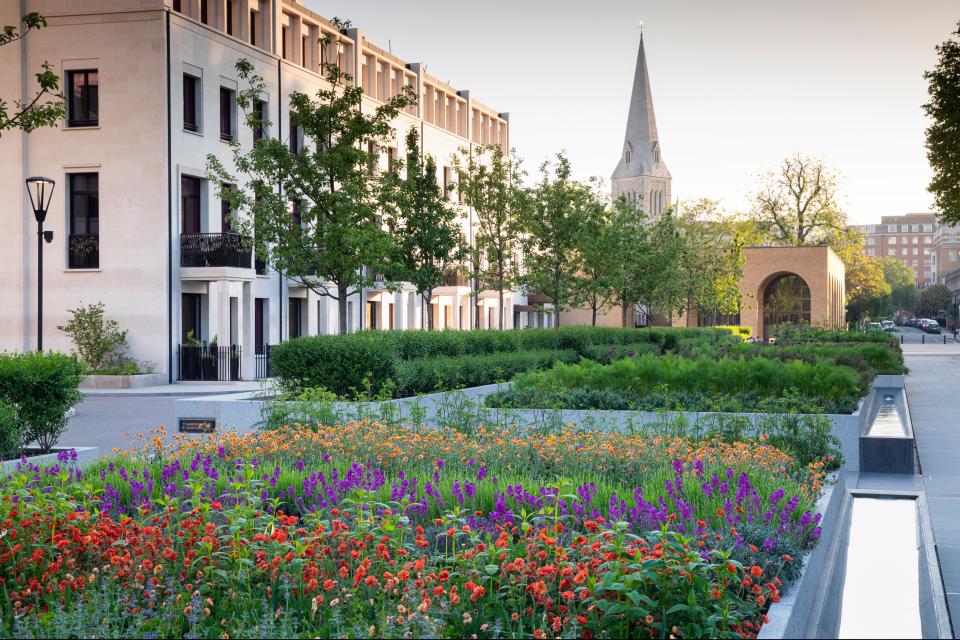London’s Chelsea Barracks named most sustainable residential development in Europe

The Chelsea Barracks exclusive enclave of apartments, penthouses and townhouses that cost up to £38 million, has been crowned the most sustainable residential development in Europe – just ahead of this week’s World Earth Day.
The former military base, which once incurred the wrath of Prince Charles, is one of only 16 schemes in the world to be awarded the much-coveted eco-credential the LEED Platinum accreditation for neighbourhood design. It is widely regarded as the benchmark for green building certification.
Sold by the Ministry of Defence to Qatari Diar (the development arm of the Qatari royal family) and British property moguls Candy & Candy in 2006 for £1 billion, the first iteration of the masterplan was met with fierce opposition from nearby residents.
Locals slammed the original design by modernist architect Lord Rogers which revealed 320 apartments across pavilions and 10-storey buildings of glass and steel, and even the Prince of Wales intervened. It was considered out of keeping with the area which is dominated by elegant period buildings.

The 12.8 acre masterplan that followed by architects Squire & Partners was based on the traditional London square garden and 40 per cent of it is now publicly accessible green space. It includes a kitchen garden, a herb garden and a garden inspired by the artist Bridget Riley.
In fact, architect Michael Squire’s vision was to create an open area that people could cut through from Chelsea Bridge Road to Pimlico Road and enjoy the greenery and water features.
The eight-floor apartment blocks reflect Belgravia’s white stucco-fronted Georgian terraces and made from Portland Whitbed – the middle layer of Portland limestone quarried on the Jurassic coast.
The creamy coloured rock is indented with tiny remnants of fossils and imprints of tiny marine creatures. The stone contains much lower levels of embodied carbon than many other construction materials and has a very long lifespan.
Other eco-credentials include: the recycling of grey water (waste water) for toilets and washing machines, green roofs, the planting of native species and increased levels of biodiversity (which means the developers added more habitats than were already there.)
The Grade II-listed chapel which was built as part of the army barracks in 1859 has been restored as an art gallery and a community centre and will open this year. It will also include leisure facilities such as a female, male and mixed saunas, relaxation areas, a business lounge and a 16-seat cinema.
As well as the 64 apartments and 13 townhouses there is one mews house tucked away in a corner of the site which was designed by one of the Duchess of Cambridge’s go-to architects, Ben Pentreath.
Prices for the apartments start from £5.25 million and the townhouses from £38 million – making it the seventh most expensive street in London, according to recent research.
The announcement of the eco-accreditation for Chelsea Barracks, in combination with World Earth Day, has prompted a flurry announcements from competitor developers and architects across London about their green projects. And some are rather more affordable.
BedZed is the sustainable village in Sutton of 100 well-insulated homes with a community biomass boiler and solar panels built on repurposed land. 52 per cent of the materials used were locally sourced from within a 32 mile radius and 15 per cent of the materials used were reclaimed. There is a two-bedroom house for sale on the site for £360,000.
Canary Wharf’s The Wardian is nearing completion, and some residents have already moved in.
The developer EcoWorld Ballymore describes the two towers as “botanically-inspired.” It’s as leafy as a skyscraper gets in the UK with planted walkways and balconies and all encased in greenhouse of 100 species of rare flowers rather than walls.
Prices start from £761,000 for a one-bedroom flat.
Read More
Reduce, reuse and retrofit: how to make your historic house more eco-friendly

 Yahoo Movies
Yahoo Movies 